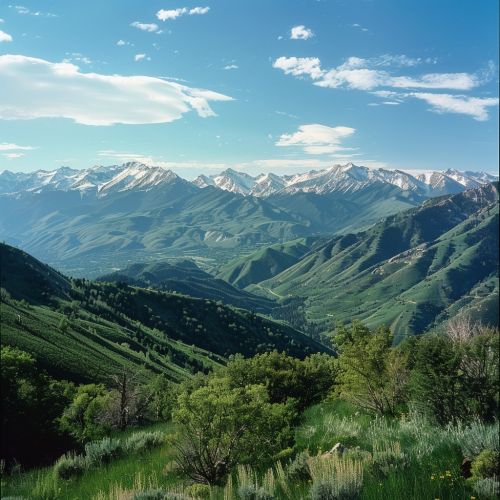Wasatch Range: Difference between revisions
(Created page with "== Geography == The Wasatch Range is a prominent mountain range located in the western United States, primarily within the state of Utah, with a small portion extending into southeastern Idaho. The range is part of the larger Rocky Mountains and stretches approximately 160 miles (260 kilometers) from the Utah-Idaho border in the north to central Utah in the south. The Wasatch Range serves as a natural boundary between the Great Basin to the west and the Colorado Plateau...") |
No edit summary |
||
| (One intermediate revision by the same user not shown) | |||
| Line 2: | Line 2: | ||
The Wasatch Range is a prominent mountain range located in the western United States, primarily within the state of Utah, with a small portion extending into southeastern Idaho. The range is part of the larger Rocky Mountains and stretches approximately 160 miles (260 kilometers) from the Utah-Idaho border in the north to central Utah in the south. The Wasatch Range serves as a natural boundary between the Great Basin to the west and the Colorado Plateau to the east. | The Wasatch Range is a prominent mountain range located in the western United States, primarily within the state of Utah, with a small portion extending into southeastern Idaho. The range is part of the larger Rocky Mountains and stretches approximately 160 miles (260 kilometers) from the Utah-Idaho border in the north to central Utah in the south. The Wasatch Range serves as a natural boundary between the Great Basin to the west and the Colorado Plateau to the east. | ||
[[Image:Detail-93401.jpg|thumb|center|Panoramic view of the Wasatch Range with snow-capped peaks and lush green valleys.|class=only_on_mobile]] | |||
[[Image:Detail-93402.jpg|thumb|center|Panoramic view of the Wasatch Range with snow-capped peaks and lush green valleys.|class=only_on_desktop]] | |||
== Geology == | == Geology == | ||
Latest revision as of 10:47, 22 June 2024
Geography
The Wasatch Range is a prominent mountain range located in the western United States, primarily within the state of Utah, with a small portion extending into southeastern Idaho. The range is part of the larger Rocky Mountains and stretches approximately 160 miles (260 kilometers) from the Utah-Idaho border in the north to central Utah in the south. The Wasatch Range serves as a natural boundary between the Great Basin to the west and the Colorado Plateau to the east.


Geology
The Wasatch Range is geologically diverse, featuring a complex mix of sedimentary, igneous, and metamorphic rocks. The range was primarily formed through tectonic activity associated with the Sevier orogeny during the Late Cretaceous period. This orogeny resulted in significant folding and faulting, which uplifted the region and created the rugged topography seen today.
The range is characterized by several notable geological features, including the Wasatch Fault, a major normal fault that runs along the western base of the range. This fault is responsible for much of the range's dramatic relief and has been the site of significant seismic activity. The Wasatch Fault is considered one of the most active and potentially dangerous faults in the United States.
Climate
The climate of the Wasatch Range varies significantly with elevation. Lower elevations experience a semi-arid climate, while higher elevations have a more alpine climate. The range receives substantial snowfall during the winter months, making it a popular destination for winter sports. Snowpack in the Wasatch Range is a critical water source for the surrounding regions, contributing to the hydrology of the Great Salt Lake and other local watersheds.
Flora and Fauna
The Wasatch Range supports a diverse array of plant and animal life, with distinct ecological zones corresponding to different elevations. Lower elevations are dominated by sagebrush and juniper woodlands, while mid-elevations feature extensive forests of aspen, Douglas fir, and lodgepole pine. At higher elevations, subalpine and alpine environments are home to species such as Engelmann spruce and alpine tundra vegetation.
The range is also home to a variety of wildlife, including large mammals such as mule deer, elk, and black bears. Predators like mountain lions and coyotes are also present. Bird species in the Wasatch Range include golden eagles, peregrine falcons, and various species of hawks and owls.
Human History
The Wasatch Range has a rich human history, with evidence of Native American habitation dating back thousands of years. The Ute and Shoshone tribes were among the primary indigenous groups that lived in and around the range, utilizing its resources for hunting, gathering, and shelter.
European exploration of the Wasatch Range began in the early 19th century, with fur trappers and traders being some of the first non-indigenous people to enter the area. The establishment of the Mormon settlement in the Salt Lake Valley in 1847 marked a significant turning point in the region's history, leading to increased settlement and development.
Recreation
The Wasatch Range is renowned for its recreational opportunities, particularly winter sports. The range is home to several world-class ski resorts, including Alta, Snowbird, Park City, and Deer Valley. These resorts attract visitors from around the world and have hosted numerous international skiing and snowboarding competitions.
In addition to winter sports, the Wasatch Range offers a variety of summer activities such as hiking, mountain biking, rock climbing, and camping. Popular hiking destinations include Mount Timpanogos, Lone Peak, and the Bonneville Shoreline Trail, which follows the ancient shoreline of Lake Bonneville.
Conservation
Conservation efforts in the Wasatch Range focus on preserving its natural beauty and ecological integrity. Several protected areas, including the Uinta-Wasatch-Cache National Forest, provide critical habitat for wildlife and opportunities for outdoor recreation. Conservation organizations work to address challenges such as habitat fragmentation, invasive species, and the impacts of climate change.
